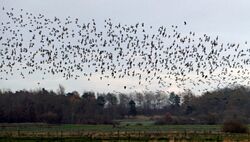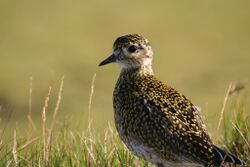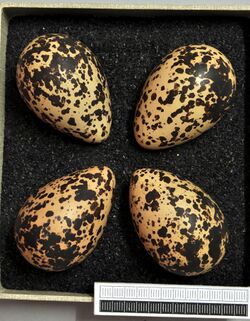Biology:European golden plover
| European golden plover | |
|---|---|
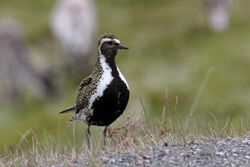
| |
| Adult in breeding plumage | |
| File:Pluvialis apricaria - European Golden Plover XC132878.ogg | |
| Calls | |
| Scientific classification | |
| Domain: | Eukaryota |
| Kingdom: | Animalia |
| Phylum: | Chordata |
| Class: | Aves |
| Order: | Charadriiformes |
| Family: | Charadriidae |
| Genus: | Pluvialis |
| Species: | P. apricaria
|
| Binomial name | |
| Pluvialis apricaria | |
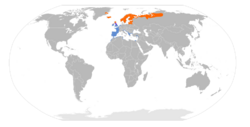
| |
| Synonyms | |
| |
The European golden plover (Pluvialis apricaria), also known as the European golden-plover, Eurasian golden plover, or just the golden plover within Europe, is a relatively large species of plover. This species is similar to two other golden plovers: the American golden plover, Pluvialis dominica, and Pacific golden plover, Pluvialis fulva, which are both smaller, slimmer and relatively longer-legged than European golden plover, and both have grey rather than white axillary feathers (only properly visible in flight).
Taxonomy
The European golden plover was formally described by the Swedish naturalist Carl Linnaeus in 1758 in the tenth edition of his Systema Naturae. He placed it with the other plovers in the genus Charadrius and coined the binomial name Charadrius apricarius.[2] The species is now placed in the genus Pluvialis that was introduced in 1760 by the French zoologist Mathurin Jacques Brisson.[3][4] The genus name is Latin and means "relating to rain", from pluvia, "rain". It was believed that golden plovers flocked when rain was imminent.[5] The species name apricaria is Latin and means "to bask in the sun".[6] The European golden plover is monotypic: no subspecies are recognised.[4]
Description
The European golden plover is quite thickset, with its wings only being slightly longer than its tail. Its most distinct feature is a white "s"-shaped band stretching from its forehead to its flanks.[7]
Distribution and habitat
The European golden plover tends to breed in the Arctic tundra and other palearctic areas, ranging as far west as Iceland, where they are called Heiðlóa, and as far east as central Siberia.[7] It tends to gather in large flocks and winter in open areas, agricultural plains, ploughed land, and short meadows, ranging from Europe to North Africa.[8][9]
In the United Kingdom , golden plover chicks rely on Tipulidae for feeding, while in Sweden Bibionidae are more important.[10]
Behaviour and ecology
The European golden plover's call is a monosyllabic, slightly descending, melancholic "tuu".[7][9]
Its flight action is rapid and powerful, with regular wingbeats.[8]
In culture
Folklore
The European golden plover spends summers in Iceland, and in Icelandic folklore, the appearance of the first plover in the country means that spring has arrived.[11] The Icelandic media always covers the first plover sighting, which in 2017, took place on March 27.[12] In 2020, the first golden plover was sighted on March 16.[13]
Origin of Guinness World Records
On 10 November 1951, Sir Hugh Beaver, then the managing director of the Guinness Breweries,[14] went on a shooting party in the North Slob, by the River Slaney in County Wexford, Ireland. After missing a shot at a Eurasian golden plover, he became involved in an argument over which was the fastest game bird in Europe, the golden plover or the red grouse (the former being correct).[15] That evening at Castlebridge House, he realised that it was impossible to confirm in reference books whether or not the golden plover was Europe's fastest game bird.[16][17] Beaver knew that there must be numerous other questions debated nightly in pubs throughout Ireland, but there was no book in the world with which to settle arguments about records. He realised then that a book supplying the answers to this sort of question might prove popular.[18] A Guinness employee told Sir Hugh of two twin brothers, Norris and Ross McWhirter, who had opened a fact checking agency in London. Sir Hugh interviewed the brothers and, impressed by their prodigious knowledge, commissioned the book. Later, he published the first Guinness World Records which became a best seller within months.[19]
Status
The European golden plover is one of the species to which the Agreement on the Conservation of African-Eurasian Migratory Waterbirds (AEWA) applies.[20]
References
- ↑ BirdLife International (2016). "Pluvialis apricaria". IUCN Red List of Threatened Species 2016: e.T22693727A86551440. doi:10.2305/IUCN.UK.2016-3.RLTS.T22693727A86551440.en. https://www.iucnredlist.org/species/22693727/86551440. Retrieved 12 November 2021.
- ↑ Linnaeus, Carl (1758) (in Latin). Systema Naturae per regna tria naturae, secundum classes, ordines, genera, species, cum characteribus, differentiis, synonymis, locis. 1 (10th ed.). Holmiae (Stockholm): Laurentii Salvii. pp. 150–151. https://www.biodiversitylibrary.org/page/727057.
- ↑ Brisson, Mathurin Jacques (1760) (in French, Latin). Ornithologie, ou, Méthode Contenant la Division des Oiseaux en Ordres, Sections, Genres, Especes & leurs Variétés. Paris: Jean-Baptiste Bauche. Vol. 1, p. 46, Vol. 5, p. 42.
- ↑ 4.0 4.1 Gill, Frank; Donsker, David; Rasmussen, Pamela, eds (July 2021). "Buttonquail, thick-knees, sheathbills, plovers, oystercatchers, stilts, painted-snipes, jacanas, Plains-wanderer, seedsnipes". IOC World Bird List Version 11.2. International Ornithologists' Union. https://www.worldbirdnames.org/bow/buttonquail/.
- ↑ "London". CiteSeerX 10.1.1.695.7104.
- ↑ Jobling, James A. (2010). The Helm Dictionary of Scientific Bird Names. London: Christopher Helm. pp. 57, 311. ISBN 978-1-4081-2501-4. https://archive.org/details/Helm_Dictionary_of_Scientific_Bird_Names_by_James_A._Jobling.
- ↑ 7.0 7.1 7.2 Frédéric Jiguet; Aurélien Audevard (2017). Birds of Europe, North Africa, and the Middle East: A Photographic Guide (illustrated ed.). Princeton University Press. p. 155. ISBN 978-0-691-17243-9.
- ↑ 8.0 8.1 Mark Beaman, Steve Madge (2010). The Handbook of Bird Identification: For Europe and the Western Palearctic (illustrated ed.). A&C Black. p. 309. ISBN 978-1-4081-3523-5.
- ↑ 9.0 9.1 Jon Lloyd Dunn, Jonathan K. Alderfer, ed (2006). National Geographic Field Guide to the Birds of North America, National Geographic Field Guide to Birds Series (illustrated ed.). National Geographic Books. p. 154. ISBN 978-0-7922-5314-3.
- ↑ Machín, P.; Fernández-Elipe, J.; Flinks, H.; Laso, M.; Aguirre, J. I.; Klaassen, R. H. G. (2017). "Habitat selection, diet and food availability of European Golden Plover Pluvialis apricaria chicks in Swedish Lapland". Ibis 159 (3): 657–672. doi:10.1111/ibi.12479.
- ↑ Jóhannsson, K. (27 March 2017). "The Golden Plover has arrived, indicating spring in Iceland". Icenews. http://www.icenews.is/2017/03/27/the-golden-plover-has-arrived-indicating-spring-in-iceland/#axzz4caJPwfcl.
- ↑ "Spring has arrived in Iceland, according to folklore". Iceland Monitor. 27 March 2017. http://icelandmonitor.mbl.is/news/news/2017/03/27/spring_has_arrived_in_iceland_according_to_folklore/.
- ↑ Poppy Askham (16 March 2020). "Rejoice, Spring Has Finally Sprung: The Lóa Lands In Iceland". The Reykjavik Grapevine. https://grapevine.is/news/2020/03/16/rejoice-spring-has-finally-sprung-the-loa-lands-in-iceland/.
- ↑ "The History of the Book". Guinness Record Book Collecting. http://guinness.book-of-records.info/history.html.
- ↑ Davenport, Fionn (2010). Ireland. Lonely Planet. p. 193. ISBN 978-1-74220-350-8. https://books.google.com/books?id=RfL3QnPMi9oC&pg=PA193.
- ↑ "Early history of Guinness World Records". 2005. p. 2. http://freespace.virgin.net/james.robertson/history2.htm.
- ↑ Cavendish, Richard (August 2005). "The Guinness Book of Records was first published on August 27th, 1955". History Today 55 (8). http://www.historytoday.com/richard-cavendish/publication-guinness-book-world-records.
- ↑ Guinness World Records 2005 (50th Anniversary ed.). Guinness. 2004. p. 6. ISBN 978-1-892051-22-6. https://archive.org/details/guinnessworldr2005guin.
- ↑ "The Guinness Book of Records, Witness - BBC World Service". http://www.bbc.co.uk/programmes/p030890m.
- ↑ "Eurasian Golden Plovers". 16 September 2021. https://beautyofbirds.com/eurasian-golden-plovers/.
External links
- Ageing and sexing (PDF; 1.4 MB) by Javier Blasco-Zumeta & Gerd-Michael Heinze
- BirdLife species factsheet for Pluvialis apricaria
- "Pluvialis apricaria". Avibase. https://avibase.bsc-eoc.org/species.jsp?lang=EN&avibaseid=.
- "Eurasian Golden Plover media". Internet Bird Collection. http://www.hbw.com/ibc/species/eurasian-golden-plover-pluvialis-apricaria.
- European Golden-Plover photo gallery at VIREO (Drexel University)
Wikidata ☰ Q21148 entry
 |

